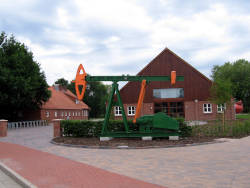Erdöl-Erdgas-Museum Twist
Useful Information

| Location: |
Flensbergstraße 13, 49767 Twist
(52.648044051983454, 7.093602098000918) |
| Open: |
All year Tue-Sun 14-18. [2021] |
| Fee: |
Adults EUR 5, School Pupils EUR 1, Students EUR 1. Guided Tour EUR 15 additionally. Audio-Guide free. [2021] |
| Classification: |
 Crude Oil Crude Oil
|
| Light: |
 Electric Light Electric Light
|
| Dimension: | Ar=450 m². |
| Guided tours: |
Audio-Guide


|
| Photography: | allowed |
| Accessibility: | yes |
| Bibliography: | |
| Address: |
Erdöl-Erdgas-Museum Twist, Flensbergstraße 13, 49767 Twist, Tel: +49-5936-93-30-82.
E-mail: |
| As far as we know this information was accurate when it was published (see years in brackets), but may have changed since then. Please check rates and details directly with the companies in question if you need more recent info. |
|
History
| 1938 | exploration well near Bentheim hits natural gas. |
| 1942 | borehole LINGEN 2 near Dalum finds crude oil in economically relevant quantities. |
| 1947 | Nederlandse Aardolie Maatschappij (NAM) jointly set up by Shell and Esso. |
Geology
Northern Germany and Holland are covered by a Mesozoic sedimentary layer several kilometres thick. There are also petroleum mother rocks there, as strongly oil-bearing rocks, for example the oil shales of the Lias. Due to the penetration of meteoric groundwater, the petroleum floats to the top because of its lower specific weight, However, the rise is stopped by impermeable layers of siltstone. Massive accumulation takes place when the layers are arched upwards. Then oil and gas rise to the highest point and are trapped there, which is called a petroleum trap. It is essential that oil from a certain environment flows together.
Usually, petroleum is found in traps tied to salt domes. From the 1930s onwards, these deposits were sought throughout the German lowlands using gravimetry. Then they were prospected with test drilling. They are still used today for the extraction of crude oil.
Description
The Erdöl-Erdgas-Museum Twist is located in the middle of Germany’s largest oil fields in terms of area in the Emsland region. The buildings, built in local brick, offer 450 m² of exhibition space. The open-air area is used to exhibit large machinery from the oil and gas operations. The museum also has a lecture room and a specialized library.
Oil production in the region is young, with natural gas only being drilled in 1938 and oil in 1942. Of course, the intensive search for oil was due to the Second World War and was primarily of strategic importance. The extraction of oil was also economically profitable in peacetime, and so the districts of Emsland and Grafschaft Bentheim as well as the Dutch province of Drenthe developed into an important European region for the production oil and natural gas. The main aspects of the museum are the formation of crude oil and natural gas, the development of deposits, the extraction, storage and transport of crude oil and natural gas. The oil is today extracted by the Nederlandse Aardolie Maatschappij (NAM) which was jointly set up by Shell and Esso in 1947.
 Search DuckDuckGo for "Erdöl-Erdgas-Museum Twist"
Search DuckDuckGo for "Erdöl-Erdgas-Museum Twist" Google Earth Placemark
Google Earth Placemark Erdöl-Erdgas-Museum Twist - Wikipedia (visited: 03-MAY-2021)
Erdöl-Erdgas-Museum Twist - Wikipedia (visited: 03-MAY-2021) Erdöl und Erdgas Museum Twist, official website
Erdöl und Erdgas Museum Twist, official website  Index
Index Topics
Topics Hierarchical
Hierarchical Countries
Countries Maps
Maps